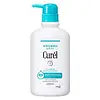What's inside
What's inside
 Key Ingredients
Key Ingredients

No key ingredients
 Benefits
Benefits

 Concerns
Concerns

 Ingredients Side-by-side
Ingredients Side-by-side

Dipotassium Glycyrrhizate
HumectantWater
Skin ConditioningAmmonium Lauryl Sulfate
CleansingC9-11 Alkyl Glucoside
CleansingLauryl Hydroxysultaine
CleansingPPG-7 Lauryl Ether
EmollientPPG-10 Lauryl Ether
Alcohol Denat.
AntimicrobialSodium Hydroxide
BufferingZinc Chloride
AntimicrobialDiallyldimethyl Ammonium Chloride
Methylglucoside Phosphate
Skin ConditioningEucalyptus Maculata Extract
Skin ConditioningMalic Acid
BufferingAcrylamide
Glyceryl Ethylhexanoate
EmollientCetyl Pyrrolidonylmethyl Dimonium Chloride
Butylene Glycol
HumectantBenzyl Benzoate
AntimicrobialDipotassium Glycyrrhizate, Water, Ammonium Lauryl Sulfate, C9-11 Alkyl Glucoside, Lauryl Hydroxysultaine, PPG-7 Lauryl Ether, PPG-10 Lauryl Ether, Alcohol Denat., Sodium Hydroxide, Zinc Chloride, Diallyldimethyl Ammonium Chloride, Methylglucoside Phosphate, Eucalyptus Maculata Extract, Malic Acid, Acrylamide, Glyceryl Ethylhexanoate, Cetyl Pyrrolidonylmethyl Dimonium Chloride, Butylene Glycol, Benzyl Benzoate
 Reviews
Reviews

Alternatives
Ingredients Explained
These ingredients are found in both products.
Ingredients higher up in an ingredient list are typically present in a larger amount.
Water. It's the most common cosmetic ingredient of all. You'll usually see it at the top of ingredient lists, meaning that it makes up the largest part of the product.
So why is it so popular? Water most often acts as a solvent - this means that it helps dissolve other ingredients into the formulation.
You'll also recognize water as that liquid we all need to stay alive. If you see this, drink a glass of water. Stay hydrated!
Learn more about Water